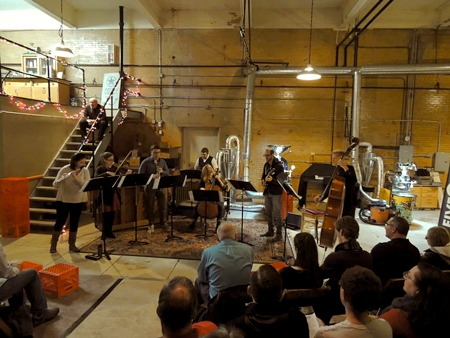by Mike Telin

And an industrial experience is exactly what a near-capacity audience was met with on Saturday March 5 when 51XO performed at the Rising Star Coffee Roastery. The concert was presented as part of the 2016 NEOSonicFest.
Located in Cleveland’s Clark-Fulton neighborhood, the Roastery is an expansive warehouse facility in the old Hildebrandt Building — the concert took place in what appeared to be the salesroom. From a side door, listeners entered a space much longer than it is wide, with a very high ceiling. A makeshift performance area was located along a side wall three-quarters of the way down.
Attendees had their choice of sitting on chairs, stools, or burlap sacks filled with coffee beans stacked along the opposite wall. The industrial experience came complete with a leaky roof and a loud heating system that was turned off at the start of the concert. Yes, it was cold by the middle of the performance. Although area rugs were placed on the floor of the performance and seating areas, acoustically the space remained extremely resonate, which was often a detriment to the music, especially during works for larger forces.
In spite of the conditions, the 51XO musicians, Audrey Whartenby (flute), Zachary West (clarinet), Chiara Stauffer (violin), Sophie Benn (cello), Tracy Mortimore (bass), Joshua Stauffer (guitar), Rob Kovacs (piano), and Evan Mitchell (percussion), rose to the occasion.
Kudos to Audrey Whartenby for her brilliant performance of Greg Pattillo’s Three Beats for Beatbox Flute (2011). After a brief explanation of beatbox techniques — the player creates vocal sounds by forming vowels in the mouth — the flutist launched into the two-part work with exuberance. Her simultaneous singing and playing was amazing.
Presenting world premieres is a 51XO tradition, and the program included two, both utilizing 51XO’s full instrumental ensemble. Reminiscent of Terry Riley’s In C, Jeremy Allen’s Manual Focus requires each player to repeat a series of musical cells using guidelines that spell out the number of repetitions they should play before moving on to the next. The musicians all play the same material, just not at the same time, giving the illusion of harmonic progression as the piece moves forward. Its minimalist quality of the worked well in the space.
Rather than providing the players with a written score, in his Seven Strategies, Tracy Mortimore gives them seven points of departure to be used as the basis for improvisation. These include pointillism, ostinato, and a single repeated note. During the performance, players take turns leading the group by using hand signals to indicate when to speed up or slow down, or to get louder or softer. It was interesting to hear the group improvisation move easily from one section to the next — a very well-organized chaos.
Other works by local composers included Buck McDaniel’s Put it all in (2014) for flute, clarinet, violin, cello, and piano, a brief work in A-B-A form full of rhythmic shifts and accents. John HC Thompson’s Fine. Whatever. Awful. Great (2015), for violin, cello, guitar, piano, and percussion is an attractive jazz-inspired work complete with solo opportunities for the players. Cellist Sophie Benn’s “break” was especially fun with its long slides and snap-pizzes.
The program began with Sarah Kirkland Snider’s Pale as Centuries (2011) for flute, clarinet, guitar, and bass, a seductive work full of driving metronomic lines. A solid reading of Nico Muhly’s virtuosic Doublespeak (2012) for flute, clarinet, violin, cello, piano, and percussion brought the evening to a conclusion.
Published on ClevelandClassical.com March 23, 2016.
Click here for a printable copy of this article




